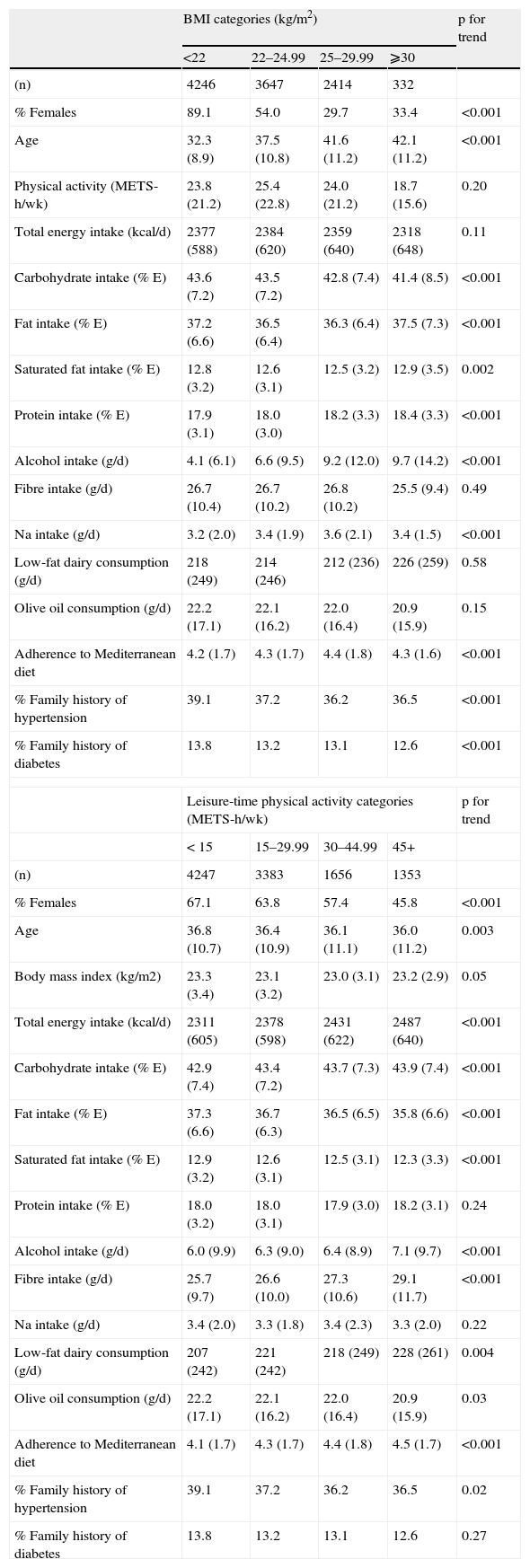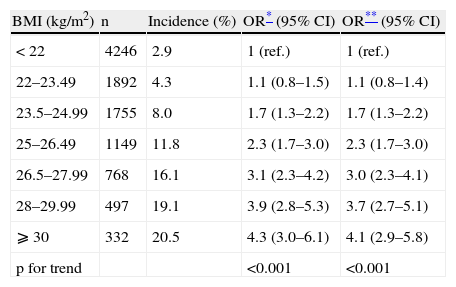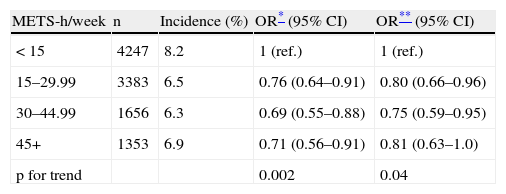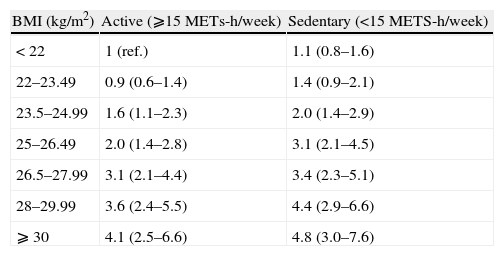Although health risks associated to excessive body fat increase with small increases in body weight, measurement of body fat is usually grouped in very few categories. The aim of our study was to assess whether the risk for a combined end-point including the incidence of either hypertension and/or type 2 diabetes mellitus and/or the metabolic syndrome was elevated even within the “normal” limits of body-mass index (BMI).
Material and methodsWe followed up 10,639 initially healthy university graduates participating in the SUN dynamic cohort for a variable period ranging 2 to 6 years. Baseline BMI and physical activity were the major exposures. The combined end-point was defined by the incidence of either hypertension and/or type 2 diabetes and/or the metabolic syndrome during the follow-up period.
We fitted non-conditional logistic regression models and nonparametric regression models (restricted cubic splines).
ResultsWe observed 768 incident cases of the combined outcome (incidence of 16/1000 person-years) and found a monotonic linear association between BMI and the combined end-point. The multivariate-adjusted odds ratios for the combined end-point were 1.4 (95% CI: 1.1–1.7) for BMI 22–24.9kg/m2, 2.7 (2.1–3.5) for 25–29.9kg/m2 and 4.0 (2.8–5.6) for ⩾30kg/m2. We observed a threshold effect in the association between physical activity and the combined end-point multivariate-adjusted odds ratio=0.8 (0.7–0.9) for >15METs-h/week.
ConclusionsOur findings suggest that the incidence of metabolic risk factors (hypertension, diabetes mellitus and/or metabolic syndrome) is already increased at a BMI of 22kg/m2 in young adults. These results deserve consideration for judging whether the cut-off point for “normal” weight should be lowered.
Aunque el riesgo asociado a excesiva adiposidad aumente con pequeños incrementos de ésta, la medida de la grasa corporal (índice de masa corporal, IMC) se ha agrupado frecuentemente en pocas categorías. Este estudio pretende valorar si el riesgo de un desenlace combinado incluyendo la incidencia de hipertensión y/o diabetes y/o síndrome metabólico se eleva incluso dentro del rango considerado habitualmente como “normal” para el IMC.
Material y métodos10.639 graduados universitarios inicialmente sanos de la cohorte dinámica SUN fueron seguidos durante un periodo variable de 2 a 6 años. El IMC y el ejercicio al inicio del estudio fueron las exposiciones estudiadas. Se definió un desenlace combinado que incluía la incidencia de hipertensión y/o diabetes mellitus tipo 2 y/o síndrome metabólico durante el seguimiento.
Se ajustaron modelos de regresión logística no condicional y no paramétricos (restricted cubic splines).
ResultadosSe hallaron 768 casos incidentes del desenlace combinado (incidencia de 16/1000 personas-año) y una asociación lineal progresiva entre el IMC y el desenlace combinado. Las odds ratios multivariables para el desenlace combinado fueron 1,4 (IC 95%: 1,1–1,7) para IMC 22–24,9kg/m2, 2,7 (2,1–3,5) para 25–29,9kg/m2 y 4,0 (2,8–5,6) para ⩾30kg/m2. Se observó un efecto umbral en la asociación entre ejercicio y el desenlace combinado odds ratio ajustada=0,8 (0,7–0,9) para > 15METs-h/semana.
ConclusionesLos resultados sugieren que la incidencia de factores de riesgo metabólicos (hipertensión, diabetes y/o síndrome metabólico) aumenta ya a partir de un IMC de 22kg/m2 en adultos jóvenes. Esto debería tenerse en cuenta para juzgar si se debe establecer un límite inferior a 25kg/m2 como criterio de “normalidad” para el IMC.
Artículo
Comprando el artículo el PDF del mismo podrá ser descargado
Precio 19,34 €
Comprar ahora












